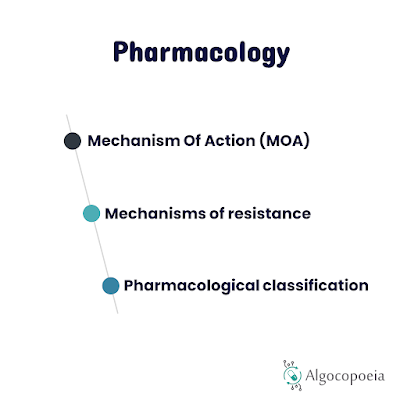
Penicillins (PNs) - In 1928, at St. Mary's Hospital, London, Sir Alexander Fleming discovered penicillin. This discovery led to the introduction of antibiotics that greatly reduced the number of deaths from infection.

Mechanism Of Action (MOA)
MOA of PNs & other β-lactam antibiotics:
- Cell wall Is composed of a polymer called peptidoglycan that consists of glycan units joined to each other by peptide cross-links forming a peptidoglycan strand.
- Each peptidoglycan strand is linked to the other adjacent strands by an enzyme called Transpeptidase to form peptidoglycan layers, in a process is called Transpeptidation.
- β-lactams structurally resemble the terminal portion of the peptidoglycan strand, so they compete for and bind with Transpeptidase (penicillin-binding proteins (PBPs)) and so interfere with peptidoglycan layers leading to a weakened cell wall and ultimately cell death - Bactericidal.

Two concepts beyond the MOA:
- β-lactams work only on actively proliferating (dividing) microorganisms - mature cells have already formed their strong cell wall structure.
- β-lactams are more active against Gram-positive bacteria:
- Gram-positive bacteria have a thick cell wall and so thick peptidoglycan layers and so are more susceptible for PNs.
- Gram-negative bacteria have a thin cell wall and so thin peptidoglycan layers and so are less susceptible for PNs.
- However, advanced generations of β-lactams have been developed to cover gram-negative bacteria.

Mechanisms of Resistance
Resistance to PNs and other β-lactams is due to one of four general mechanisms:
- Inactivation of antibiotic by β-lactamases (For PNs: Penicillinase) - The most common mechanism.
- Modification of target (penicillin-binding proteins (PBPs)) - Such as in MRSA.
- Impaired penetration of drug to target PBPs.
- Antibiotic efflux - Drug is pumped out of the cell.

PNs Classifications
1. Narrow spectrum PNs:
- Narrow spectrum penicillinase susceptible agents - Natural PNs
- Penicillin G (Benzylpenicillin)
- Penicillin G benzathine
- Penicillin G procaine
- Penicillin V (Phenoxymethylpenicillin)
- Very narrow-spectrum penicillinase-resistant drugs - Antistaphylococcal PNs
- Methicillin - Discontinued
- Nafcillin
- Oxacillin
- Dicloxacillin
- Flucloxacillin - Not FDA approved
2. Wider spectrum PNs:
- Extended-spectrum PNs - Aminopenicillins
- Ampicillin
- Amoxicillin
- Pivampicillin - Not FDA approved
- Antipseudomonal PNs
- Ureidopenicillins: Piperacillin
- Carboxy PNs: Carbenicillin, Ticarcillin - Discontinued

- Extended-spectrum penicillins: Some resources refer to them as Wider spectrum PNs - so Extended-spectrum penicillins may refer to both types of wider spectrum PNs or just to Aminopenicillins.
- Methicillin: Very limited use because of potential nephrotoxicity (interstitial nephritis).
- Not FDA approved: Are found in products not approved by the FDA but are used extensively outside the USA.
- Discontinued: Are found in products with FDA approval, but aren't available in the USA market (have never been marketed, have been discontinued from marketing, are for military use, are for export only, or have had their approvals withdrawn for reasons other than safety or efficacy after being discontinued from marketing) – Mentioned for extra-classification information.
Intra-class differences

2. Antimicrobial spectrum:
- Natural PNs: Active against gram-positive bacteria, but are sensitive against Penicillinase (e.g. Not Penicillinase producing staphylococcus aureus).
- Antistaphylococcal PNs: Active against gram-positive bacteria & Penicillinase stable (restricted to: Penicillinase producing staphylococcus aureus (MSSA But not MRSA)).
- Aminopenicillins: Active against both gram-positive and gram-negative bacteria, but are sensitive against Penicillinase (compilation with β-lactamase inhibitors may solve the problem).
- Antipseudomonal PNs: Active against both gram-positive and gram-negative bacteria and extended to cover pseudomonas aeruginosa, but are sensitive against Penicillinase (compilation with β-lactamase inhibitors may solve the problem, restricted to: Pseudomonas aeruginosa)

- Stable: Oral bioavailable.
- Not stable: Not Oral bioavailable.
- However, other factors may be considered.
|
Narrow spectrum penicillinase susceptible agents (Natural PNs) |
|||
|
criteria |
β-lactamase |
Oral absorption |
Notes |
|
Penicillin G |
Sensitive |
Poor |
Much more active than Penicillin V |
|
Penicillin G benzathine |
Sensitive |
Poor |
Long-acting formulations of Penicillin G (Depot forms) |
|
Penicillin G procaine |
Sensitive |
Poor |
|
|
Penicillin V |
Sensitive |
Good |
|
|
Very narrow spectrum penicillinase resistant drugs (Antistaphylococcal PNs) |
|||
|
Nafcillin |
Resistant |
Poor |
|
|
Oxacillin |
Resistant |
Poor |
|
|
Dicloxacillin |
Resistant |
Good |
Better oral bioavailability than cloxacillin |
|
Flucloxacillin |
Resistant |
Good |
Better oral bioavailability than cloxacillin |
|
Extended spectrum penicillins – Aminopenicillins |
|||
|
Amoxicillin |
Sensitive |
Excellent |
|
|
Ampicillin |
Sensitive |
Good |
|
|
Pivampicillin |
Sensitive |
Excellent |
Better oral bioavailability than Ampicillin |
|
Antipseudomonal penicillins |
|||
|
Piperacillin |
Sensitive |
Poor |
|
5. Cross-hypersensitivity.
References
BOOKS & RESEARCHES
- Lippincott Illustrated Reviews: Pharmacology - 7th Edition
- Katzung & Trevor's Pharmacology Examination and Board Review - 12th Edition
- Basic and Clinical Pharmacology - 14th Edition
- Goodman and Gilman's The Pharmacological Basis of Therapeutics - 12th Edition
- Goodman and Gilman's The Pharmacological Basis of Therapeutics - 13th Edition
- Color Atlas of Pharmacology - 5th Edition
- Pharmacokinetics of flucloxacillin and cloxacillin in healthy subjects and patients on chronic intermittent haemodialysis - E H Nauta, H Mattie (1975)
- Dicloxacillin and cloxacillin: pharmacokinetics in healthy and hemodialysis subjects - E H Nauta, H Mattie (1976)

Post a Comment